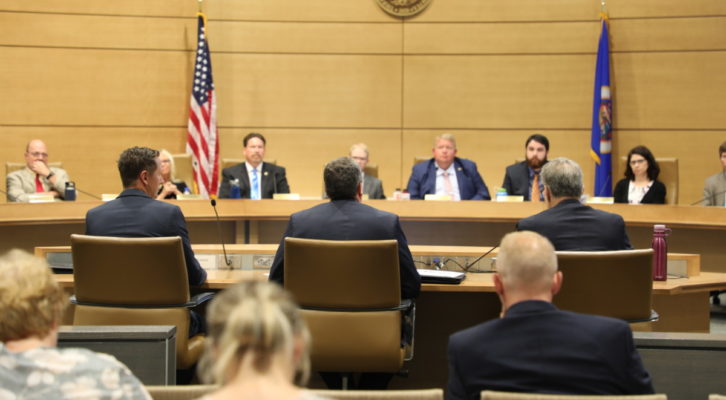Today marked the first gathering of the Senate Select Committee on Homeownership Affordability and Availability.
Chaired by Senator Rich Draheim, a builder and developer from Madison Lake, the committee heard testimony from David Siegel, Executive Director; John Rask, 2019 President; and Tony Wiener, Cardinal Homebuilders. The three focused on the lack of inventory, the inability to meet the market demand, and why it costs so much more to build in Minnesota. You can read the full testimony here.
This is the first gathering of the Senate Select Committee that is scheduled to meet monthly. The Legislative Commission on Housing Affordability is also expected to gather in the coming weeks.
Here is Siegel’s full Testimony Before the Senate Select Committee on Homeownership Affordability and Availability
Good afternoon Chair Draheim and members of the Select Committee – I’m David Siegel, the Executive Director of Housing First Minnesota – we’re a trade association comprised of over 1,100 companies that build, remodel, develop, and supply materials for homeowners throughout the state of Minnesota.
The convening of this select committee marks an important moment for housing in Minnesota. Going back decades, the land use, technical building, and policy discussions were siloed throughout an array of committees and rarely, perhaps never, reviewed together as a system by the legislature. The legislature defined ‘housing’ primarily through the lens of housing subsidy proposals and programs, and focused its work on the host of these funding mechanisms. This work is important and must be part of the housing discussion in Minnesota – but there is so much more that goes into housing policy, and today marks the opportunity for the legislature to begin this important, and broad-based work.
The convening of the Select Committee comes at a time when housing in Minnesota is deep trouble. As you heard earlier from our friends in the REALTOR Community – we have a critical shortage of available homes for purchase – which puts pressure on home prices and rental costs – and the entire eco-system of our housing market. As you can see here, we have been falling behind by tens of thousands of units for the past decade and 2019 is off to a mediocre start, falling far short of what Minnesota’s housing market is demanding.
This observation is shared across the board – by public, private, and industry thought leaders – all of whom have come to the same conclusion: the chronic under-supply of homes over the last decade-plus has put Minnesota’s housing market in deep peril and stands to get worse if urgent action isn’t taken.
There is also shared consensus on how to fix this problem: we need a surge of newly built homes – single family, townhomes, condos and apartments – roughly 10,000 more homes beyond our current output for the next 12 years by the private sector – built primarily at the workforce, first-time, and move-down price levels.
One would think that a trade organization of homebuilders and remodelers would be the most optimistic group in the state with such a prescription, but unfortunately we are not.
While a sustained surge in home building is the clear answer to our housing market’s challenges – we face an even larger one.
We simply can’t build the necessary homes today because it costs far too much to construct workforce homes in Minnesota.
This problem is impacting many markets throughout the U.S. – but our state is among the most challenged in the country, and in middle America our inventory and affordability challenges are the worst.
This chart shows that our Midwestern peers are outpacing the MSP market when it comes building new homes for under $300,000, as shown by the blues. The vast majority of today’s housing demand is in this price range.
We have devoted substantial time to better understand what is driving the costs in our region’s market. And what we’ve learned in comparisons with our peer regions – is that labor costs are comparable; material costs are comparable; profit and overhead are comparable.
But, the land and regulatory costs are more expensive here than the rest of Middle America.
When homebuilding companies are studying our market and considering locating here, they are literally astounded at our land costs. As a region, we are situated in the middle of the country with few, if any, geographic barriers for growth that lead to high land costs in places like California and the Pacific Northwest.
So why is land so expensive here?
The primary driver is the land rationing impacts of the Met Council’s growth boundary, how it is implemented by local governments and finally how it’s perceived by land sellers along the growth boundary.
This slide shows adjacent pieces of land from within the MUSA line to outside the MUSA line can be anywhere from three to fifteen times more expensive.
In the simplest of terms, our policies restrict land for purchase, and like any product where supply is low and demand is high, the price increases.
The industry leaders here with me today will share some specific experiences they have with land purchasing in our market, but I want to note that the real downside of restricting land, is that it promotes the very phenomenon it hopes to avoid: leap frog development outside of the growth plane.
As an industry we share the objective for orderly growth, but there is no question that the well-intentioned land use policies in the MSP region have led to expensive land costs, all of which are passed onto homeowners – who either pay more than they should be, or worse, they are forced to leap frog miles out into the ex-urban areas where land is cheaper.
On top of land costs, we find that, by nearly every measure, the regulatory costs in our market are higher than our peer markets. There are literally hundreds of regulatory requirements placed upon homeowners who wish to build a new home.
These include major items, like the building code, energy code, stormwater permit and wetland mitigation.
But they also includes things like lot width, structure height, setback space from the road, space between adjacent properties, and even the types of exterior material allowed.
It continues to tree replacement requirements, park dedication fees, trail fees, street construction, infrastructure hook-ups, and engineering fees – where developers and their customers pay for their own engineering, and then they pay the city’s engineering costs to check the engineer’s work.
Our industry leaders will walk through this in greater detail, but it’s important to note that these requirements are imposed by state agencies like the Department of Labor and Industry and MPCA; regional agencies like the Met Council and watershed districts; and of course locally by cities, towns, and counties.
As an industry, we support the vast majority of these regulations. The challenge in them is the overlap, the duplication of oversight, and the lack of cost-effectiveness embedded in the regulatory structure.
If we want to fix our housing market, it will require a reimagination of housing. And the first thing we must do, is to address regulatory costs head-on.
There are steps being taken at the state level where we have seen improvements in the regulatory rule process – but we have a ways to go on coordinating and finding performance-based cost alternatives.
At the regional level – there must be a review of Met Council land policies to balance out the supply and land cost challenges. The legislature must also look at watershed district permitting and oversight activity relating to development. This issue has grown in urgency as we are finding agencies pitted against one another with conflicting and duplicative oversight – adding costs to homeowners trying to build in their community.
And perhaps the greatest area in need of improvement: local governments.
There is a growing awareness nationally that the fix for our housing crisis will come via local government planning and zoning reform. We agree with this assessment, and feel that Minnesota must move purposefully to reimagine a better way for homebuilding projects to work through the cities and towns of our great state.
In Minnesota, we are attempting to avoid the complete collapse of housing that is being experienced in California. Their legislature has spent the past several years in discussions with groups similar to this Select Committee, and just last week California released legislative audit results on the housing crisis. The findings were sobering. From the legislative study:
“…Local fees on development are so burdensome that they are reducing the ability to construct needed housing and increasing the cost of living for residents.
If we have any hope of lifting our communities out of this crisis, then our local fees must be aligned with our statewide production needs.”
Looking at this locally, it’s critical to understand how these fees impact homeowners. In our region, virtually all development is negotiated via a subdivision agreement between a developing property owner and local government, usually a city. These contracts are also known as Subdivision Agreements.
The theory behind the use of Subdivision Agreements is that they deliver a measure of flexibility for all parties to respond to the nuances of a given development project.
While there is some flexibility that benefits homeowners and the builders and developers they employ – far and away the benefits fall toward the local government.
It’s important to note that not all cities use subdivision agreements with the same degree of intensity. But it is unquestionably a top-tier issue impacting the cost of housing.
Why is this the case?
Subdivision agreements are gateways to project approvals – without them signed and agreed upon – homes cannot be built.
And therein lies the challenge. Terms and conditions are routinely placed in development agreements that are unfair and disproportionate, lack a connection to the underlying project, or are simply illegal and not authorized by the legislature.
Yet over and over; year in and year out – these subdivision agreements are held over the heads of housing proposals – if they are signed, the project goes forward. If they are not signed – the project stalls.
The Minnesota Supreme Court unanimously ruled on this very dynamic one year ago this week, in the Harstad v. Woodbury case. Woodbury required an unauthorized, off-site transportation fee in a subdivision agreement. Woodbury conditioned approval of the development on the acceptance of the illegal fee, and then defended the fee as ‘voluntary’ and agreed upon by both parties. This single fee, among the hundreds of requirements – was nearly $8,000 per homeowner.
The district, appellate and supreme courts unanimously disagreed with the City of Woodbury – and the MN supreme court offered the following opinion on the use of subdivision agreements:
“The pearl of great price here is approval of the subdivision agreement…a developer who fails to make a ‘voluntary’ payment in an amount Woodbury finds acceptable faces the prospect of denial of the subdivision application…there is nothing voluntary about it.”
There are many issues impacting housing – but as challenging as it may be – we must confront the use of subdivision agreements to extract and extort unfair conditions and cash from would-be homeowners.
So where do we go from here?
Our housing market must be re-balanced and positioned for the future.
We must re-imagine housing.
A re-imagined housing market will need an overhaul – a Marshall Plan to rebuild the way we grow, build, and plan for our future.
We are in the field with two major innovation projects; one for the physical structure of the home, and one for the land it’s built upon. We will be releasing detail in the coming months and hope that all stakeholders in the housing space join us.
Other markets across the country are able to do it. Minnesota was able to do it for past generations with your typical three bedroom, two bath, small garage workforce house. Today’s workforce, first-time, and down-sizing homebuyers are counting on us to provide more affordable homes. It must be done.

















